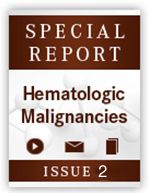Bortezomib Triplet Emerges as the New Standard of Care in Patients With Untreated Multiple Myeloma
The SWOG S0777 trial data shows induction therapy with a triplet of bortezomib, lenalidomide, and dexamethasone improved both progression-free survival and overall survival over lenalidomide and dexamethasone alone in patients with untreated multiple myeloma.
Bortezomib Triplet New Standard of Care Untreated Multiple Myeloma

Brian Durie, MD
The SWOG S0777 trial data shows induction therapy with a triplet of bortezomib (Velcade), lenalidomide (Revlimid), and dexamethasone improved both progression-free survival (PFS) and overall survival (OS) over lenalidomide and dexamethasone alone in patients with untreated multiple myeloma.
The findings of the phase III trial were presented at the 2015 ASH Annual Meeting by lead investigator Brian Durie, MD. In the study, there was a 13-month improvement in PFS and a 29% reduction in the risk of death with the triplet compared with lenalidomide and dexamethasone alone. Findings from the study suggest the triplet should be a new standard of care for untreated patients with multiple myeloma.
“There is a striking benefit of the three drug Velcade, Revlimid, and dexamethasone [VRd] regimen versus Revlimid/dex. This is significant,” said Durie, attending physician, Cedars-Sinai Medical Center. “There is a 1-year difference in overall survival.”
In the trial, 473 patients were randomized between 2008 and 2012 to receive bortezomib plus lenalidomide and dexamethasone (n = 243) or the immunomodulatory agent and corticosteroid alone (n = 230). Those enrolled did not intend to receive immediate autologous stem cell transplant following progression. Fewer women participated in the bortezomib arm compared with the control group (37% vs 47%;P= .033), as well as fewer patients who were ≥65 years of age were treated with the triplet versus the doublet (38% vs 48%;P= .042).
In the doublet arm, lenalidomide was administered at 25 mg per day on days 1 to 21 along with oral dexamethasone at 40 mg on days 1, 8, 15, and 22 for six 28-day cycles. In the triplet cohort, lenalidomide was administered at 25 mg per day on days 1 to 14 and dexamethasone was given at 20 mg on days 1, 2, 4, 5, 8, 9, 11, and 12. Intravenous bortezomib was administered at 1.3 mg/m2 on days 1, 4, 8, and 11 for eight 21-day cycles.
All patients received 325 mg of aspirin each day. Those in the triplet arm received herpes simplex virus prophylaxis. After the induction phase, patients received maintenance lenalidomide and dexamethasone for a median of 385 days. The primary endpoint of the study was PFS, with secondary outcome measures focused on objective response rates (ORR), OS, and safety.
Median PFS with bortezomib was 43 versus 30 months with lenalidomide and dexamethasone alone (HR, 0.712; 96% CI, 0.560-0.906; one-sided P = .0018). The median OS was 75 months in the bortezomib arm compared with 64 months for the doublet (HR, 0.709; one-sided P = .0125). After more than 72 months of follow-up for some patients, 72.3% remained alive in the bortezomib arm versus 58.6% with the doublet.
“VRd with continuous Rd maintenance significantly improves PFS and OS versus Rd alone with ongoing maintenance,” Durie said. “The PFS is actually quite good in the lenalidomide/dexamethasone armthis could be from the age of the patients in the study.”
The complete response rates were 15.7% and 8.4%, with bortezomib and without. The very good partial response rate with bortezomib was 27.8% versus 23.4% with the doublet alone. The ORR was 81.5% with the triplet and 71.5% for the doublet.
“The documentation of complete response requires bone marrow from these patients,” said Durie. “It's unfortunate that we didn't always have that documented for some patients. It probably would have led to a better CR rate.”
In a multivariate age-adjusted analysis, the addition of bortezomib was still found to significantly impact PFS (HR, 0.73) and OS (HR, 0.74), when compared with lenalidomide and dexamethasone alone. Across ISS stage and age, the bortezomib triplet showed a consistent advantage over the doublet.
The addition of bortezomib was well-tolerated, with an expected increase in grade ≥3 neuropathy (24% vs 5%; P <.0001). The most frequently occurring grade ≥3 hematologic adverse events (AEs) with and without bortezomib, respectively, were lymphopenia (23% vs 18%), neutropenia (19% vs 21%), thrombocytopenia (18% vs 14%), leukopenia (14% vs 16%), and low hemoglobin (13% vs 16%).
The most common non-hematologic grade ≥3 AEs for the triplet and doublet, respectively, were fatigue (16% vs 14%), sensory neuropathy (23% vs 3%), hyperglycemia (7% vs 11%), thrombosis/embolism (8% vs 9%), hypokalemia (9% vs 6%), muscle weakness (7% vs 4%), diarrhea (8% vs 2%), and dehydration (8% vs 2%).
“Obviously, these data are in a sense historical data, now that we've moved away from IV Velcade," Durie said. “The subQ Velcade tolerance is better, providing a much better ability to stay on the regimen.”
References
- Durie B, Hoering A, Rajkumar V, et al. Bortezomib, lenalidomide and dexamethasone vs. lenalidomide and dexamethasone in patients (pts) with previously untreated multiple myeloma without an intent for immediate autologous stem cell transplant (ASCT): Results of the randomized phase III trial SWOG S0777. Presented at: 57th American Society of Hematology Annual Meeting; Orlando, Florida; December 5-8, 2015. Abstract 25.

Survivorship Care Promotes Evidence-Based Approaches for Quality of Life and Beyond
March 21st 2025Frank J. Penedo, PhD, explains the challenges of survivorship care for patients with cancer and how he implements programs to support patients’ emotional, physical, and practical needs.
Read More